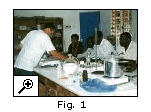|
|
 |
|
| |
Our goal with the Pollution Special Study (PSS) has been to: identify the main sources of pollution, to determine where and how such pollution is negatively impacting biodiversity, and establish a monitoring programme for pollution in the lake.

For a monitoring programme to be sustainable, it is important to work within national institutions based on the lake. At some of our more remote stations, we have worked at fisheries stations which normally do not have the mandate to study pollution. Consequently, extensive training of national staff in pollution sampling and chemical methods was necessary at the beginning of the PSS work programme. This training was successfully completed and all four stations have trained teams to monitor pollution of the lake's waters (Fig. 1).
One of the main emphases of the Pollution Special Study has been to monitor general limnological parameters which reflect the overall health of the waters.

These studies show that Bujumbura Bay (Burundi) is the richest in nutrients and thus most impacted by human activity (Fig. 2). But PSS data indicate that even much smaller cities, like Kigoma, Tanzania and Mpulungu, Zambia are showing that human inputs are having a significant impact on the water quality.
Nutrient and water clarity data from the Tanzanian coast show that Kigoma Bay is eutrophying and that untreated waters from Kigoma Bay are not safe for human consumption. Similar studies in Mpulungu show fewer indicators of eutrophication.
Plankton data indicate eutrophic species are abundant in Bujumbura Bay, common in Kigoma Bay, and rare in Mpulungu Bay, compared to the abundance of these species in open waters or in waters adjacent to protected catchments (Fig. 3).
|
|